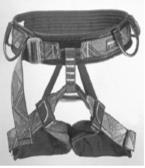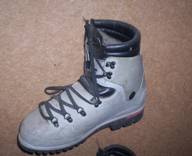Mountaineering Equipment
| 1. Helmet. Protects climber head from falling rock, stones, ice or sudden impact against the rock at climbing or falling. Helmets consists of outer shell, adjustable mount, headband adjuster and vent holes |
|
||||||||||||||
|
2. Harness. Harness are designed to protect a fall of a climber by distributing the force of a fall over large percentage of the body. Harness makes rappelling, jumaring or technical climbing much more comfortable. Harnesses are of two types ie Full body harness and seat harness. | ||||||||||||||
| 3. Boot Multipurpose. Consists of inner insulating boot and plastic shell. They can be used for walking, climbing, skiing in snowy, icy or mixed terrain with crampons on or without them. |
|
||||||||||||||
|
4. Rock climbing boots. Meant to be used especially for rock climbing. They are made of a soft and flexible upper and a smooth, flexible rubber sole. The rubber sole made from compound developed to provide the best friction between rock and shoe. | ||||||||||||||
| 5. Rope Climbing. Rope Climbing is also called as dynamic rope, with stretch of 6-8%. Climbing rope is composed of a core of braided or parallel nylon filaments encased in a smooth, woven sheath of nylon. |
|
||||||||||||||
|
6. Rope Rappelling. Also called as static rope. These are more rough and resistant to wearing out, with a stretch of 2-3 %. | ||||||||||||||
| 7. Sling. Loops of tubular webbing or cord, called slings or runners, are the simplest pieces of equipment and some of the most useful. The uses for these simple pieces are endless, and they are a critical link between the climber, the rope, carabiners, and anchors. Runners are predominately made from either 9/16-inch or 1-inch tubular webbing and are either tied or sewn by a manufacturer. |
|
||||||||||||||
|
8. Carabiners. One of the most versatile pieces of equipment available to the mountaineer is the carabiner. This simple piece of gear is the critical connection between the climber, his rope, and the protection attaching him to the mountain. Carabiners are of two types ie screw type carabiner and plain carabiner. |
||||||||||||||
| 9 Rock Pitons. A piton is a metal pin that is hammered into a crack in the rock. They are described by their thickness, design, and length. Pitons provide a secure anchor for a rope attached by a carabiner. They are made of malleable steel, hardened steel, or other alloys. Rock pitons are of two type ie vertical rock piton and horizontal rock piton. |
|
||||||||||||||
|
10. Rock Hammer. Is a climbing tool, with flat striking surface for driving pitons and a pick for pulling out protections, clearing cracks. A shaft can be wooden or of steel and dressed with robber for better grip. | ||||||||||||||
Training
The Jawahar Institute of Mountaineering and Winter Sports (JIM&WS).
Contact Us
The Jawahar Institute of Mountaineering and Winter Sports (JIM&WS)
Address: Nunwan Pahalgam (J&K)
Telephone: 01936-243129
01936-243129 (Training Section)
01936-243002 (PA to Principal)
9906967831 (Training Clerk)
9906967822 (Sub centre, Sanasar)
9906967821 (CPIO)
E-mail CPIO: principal@jawaharinstitutepahalgam.com
Fax:01936-243129
E-mail: principal@jawaharinstitutepahalgam.com
© Copyright JAWAHAR INSTITUTE OF
MOUNTAINEERING & WINTER SPORTS NUNWAN, PAHALGAM.Corporate Mail
Design, Development and Hosting of Website by Say Technologies



















